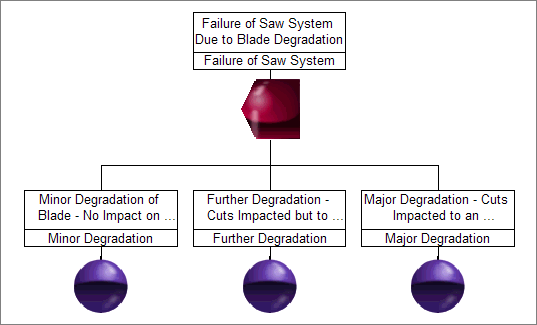Sequence Enforcing Gate
The sequence enforcing gate forces events to occur in a particular order. The input events are constrained to occur in the left-to-right order in which they appear under the gate. This means that the right-most event occurs only after the event on its immediate left, which must occur before the event on its immediate left, and so on. In other words, the occurrence of an input triggers or activates the input on its immediate right. The sequence enforcing gate is used to indicate that the output occurs if and only if all input events occur in the specified order.

The occurrence of the inputs for a sequence enforcing gate follows a sequential order. In other words, an event connected to this type of gate is initiated immediately after occurrence of its immediate left event.
The sequence enforcing gate can be contrasted with the priority AND gate in that the priority AND gate detects whether events occur in a particular order (but the events can occur in any order), whereas the sequence enforcing gate forces the events to occur only in the specified order.
The left-most input to a sequence enforcing gate can be a terminal event or outputs of any AND gate, OR gate, or dynamic gate. Only basic events are allowed for all other inputs.
You can rearrange the events that enter sequence enforcing gates by clicking and dragging them to new locations. However, rearrangement is not allowed if the first input is an output from another gate.
Summary of Logic: The output is TRUE if and only if all input events are TRUE; input events must occur in a particular order.
A truth table for a sequence enforcing gate with three input events follows.
Input 1 A | Input 2 B | Input 3 C | Output |
|---|---|---|---|
F | F | F | F |
F | F | T | Not possible |
F | T | F | Not possible |
F | T | T | Not possible |
T | F | F | F |
T | F | T | Not possible |
T | T | F | F |
T | T | T | T |
Example
A sequence enforcing gate is often used to show gradual degradation. Consider a saw system where system status is based on the quality of the blade. Initially, there may be minimal degradation to the blade such that the system is still functioning in a good condition. Next, there may be some degradation to the blade, such that the cuts are impacted, but the system is still functioning to some acceptable degree. Finally, there may be some point where the degradation of the blade produces cuts that are unacceptable, at which time the system is considered to be failed.
